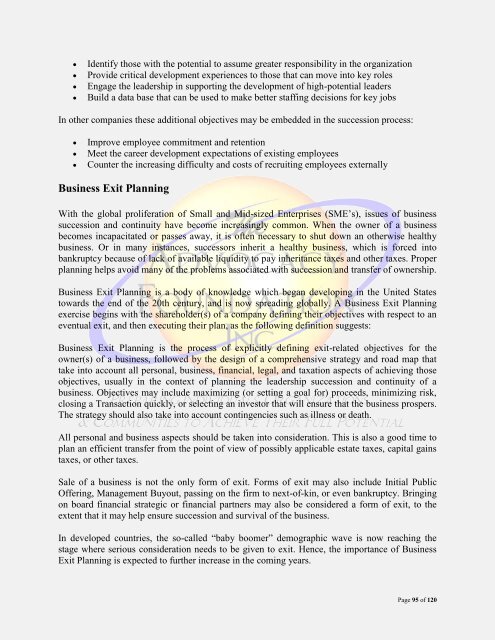Organizational Development - Vol. V, Part II
Organizational Development - Vol. V, Part II
Organizational Development - Vol. V, Part II
Create successful ePaper yourself
Turn your PDF publications into a flip-book with our unique Google optimized e-Paper software.
Identify those with the potential to assume greater responsibility in the organization<br />
Provide critical development experiences to those that can move into key roles<br />
Engage the leadership in supporting the development of high-potential leaders<br />
Build a data base that can be used to make better staffing decisions for key jobs<br />
In other companies these additional objectives may be embedded in the succession process:<br />
<br />
<br />
<br />
Improve employee commitment and retention<br />
Meet the career development expectations of existing employees<br />
Counter the increasing difficulty and costs of recruiting employees externally<br />
Business Exit Planning<br />
With the global proliferation of Small and Mid-sized Enterprises (SME‘s), issues of business<br />
succession and continuity have become increasingly common. When the owner of a business<br />
becomes incapacitated or passes away, it is often necessary to shut down an otherwise healthy<br />
business. Or in many instances, successors inherit a healthy business, which is forced into<br />
bankruptcy because of lack of available liquidity to pay inheritance taxes and other taxes. Proper<br />
planning helps avoid many of the problems associated with succession and transfer of ownership.<br />
Business Exit Planning is a body of knowledge which began developing in the United States<br />
towards the end of the 20th century, and is now spreading globally. A Business Exit Planning<br />
exercise begins with the shareholder(s) of a company defining their objectives with respect to an<br />
eventual exit, and then executing their plan, as the following definition suggests:<br />
Business Exit Planning is the process of explicitly defining exit-related objectives for the<br />
owner(s) of a business, followed by the design of a comprehensive strategy and road map that<br />
take into account all personal, business, financial, legal, and taxation aspects of achieving those<br />
objectives, usually in the context of planning the leadership succession and continuity of a<br />
business. Objectives may include maximizing (or setting a goal for) proceeds, minimizing risk,<br />
closing a Transaction quickly, or selecting an investor that will ensure that the business prospers.<br />
The strategy should also take into account contingencies such as illness or death.<br />
All personal and business aspects should be taken into consideration. This is also a good time to<br />
plan an efficient transfer from the point of view of possibly applicable estate taxes, capital gains<br />
taxes, or other taxes.<br />
Sale of a business is not the only form of exit. Forms of exit may also include Initial Public<br />
Offering, Management Buyout, passing on the firm to next-of-kin, or even bankruptcy. Bringing<br />
on board financial strategic or financial partners may also be considered a form of exit, to the<br />
extent that it may help ensure succession and survival of the business.<br />
In developed countries, the so-called ―baby boomer‖ demographic wave is now reaching the<br />
stage where serious consideration needs to be given to exit. Hence, the importance of Business<br />
Exit Planning is expected to further increase in the coming years.<br />
Page 95 of 120

















